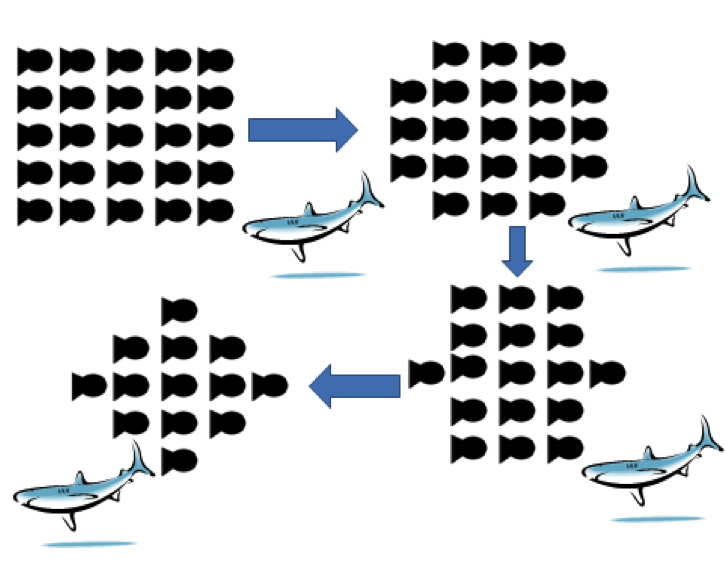| << Chapter < Page | Chapter >> Page > |
Interestingly enough, many individual fish from a school try to examine a predator alone, or be the first from the school to do so. At first, this may appear altruistic, but experiments with the Trinidadian guppy show that individuals who have information about a predator are more likely to be protected within a school and given extra resources in attempts by others to coax this valuable information from the informed individual. Therefore, competition often exists to be the informed fish so that one may garner the later benefits of protection by the group (Pitcher 1991) - predator evaluation is actually not an altuistric behavior! This one behavior highlights an important aspect of schooling: competition does exist within the school to have the safest positions and best resources as this increases chances of more reproduction, and therefore individual fitness. The Geometry of the Selfish Herd very accurately analyzes that fish will compete for the best spots within the school (Hamilton 1970), and this type of evaluation behavior is just another way to compete for those spots.
The ability of fish to evaluate predators and adapt to new predator densities indicate that fish do have learning capabilities. The ability to identify predators is learned, rather than innate, from other individuals in a high density predator area (Kelley et al 2002). Trinidadian guppies from streams without predators were placed individually into high predator environments with schools. These individuals quickly followed the lead of others in the school and engaged in anti-predatory behavior they never engaged in before, particularly schooling itself, indicating that schooling can improve individual fitness by allowing the opportunity to learn from examples ( [link] ) (Kelley et al 2002). Once again, individuals with limited knowledge of a new area are more likely to school for the selfish advantages it could provide them. It was also seen that those who did not catch on quickly were the first to be eaten, demonstrating that anti-predator behavior is selected for in high predator environments (Magurran et al 1992).
Aggregations of fish are more likely to attract predators that might not have otherwise seen them. To test the hypothesis that fish do have a mechanism to adapt to predator density to compensate for this potential cost, a study of Norwegian herring observed that percentage of time schooling is proportional to the density of predators. Fish do not school as often in low predator density areas because they have a higher chance of attracting predators that would not have otherwise noticed them as solitary individuals (Pitcher 1996).

The shape of fish schools evolves in response to various stressors . The most obvious of these stressors is a predator. A fish that decides to school in the corners of a square shaped school are most likely to be eaten first by a predator (Parrish 1991). Over the course of time, the school adapts to the manner in which the predator attacks the school, and develops an ideal density, shape, and movement direction. Stressors can be either positive or negative. Fish in a more ideal position for food will be healthier and therefore more likely to mate, and fish who school in locations where they will continually run into objects in the environment will be more likely to lose the school (Zheng et al 2005). As such, forces like predation, foraging efficiency, and prime location influence the evolution of school shape, each of which is unique for a specific environment. The ability to obtain the best location within a school is driven by fitness, with the most fit getting the center positions (Hamilton 1970). The predator also adapts to the schooling, as seen in piscivorous fish who feed on rock cod. The predators are forced to eat less nourishing prey for periods of time until the number of fish skilled in catching the schooling cod increases and the pressure to school decreases. Then once again, schooling behavior increases as predatorial success also increases, demonstrating the coevolution between predator and prey (Beukers-Stewart and Jones 2003).

Notification Switch
Would you like to follow the 'Mockingbird tales: readings in animal behavior' conversation and receive update notifications?